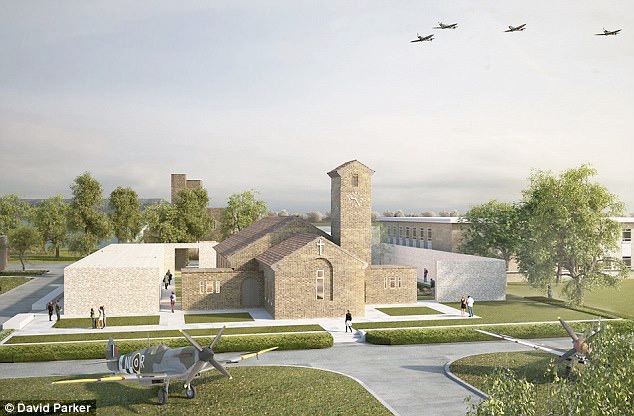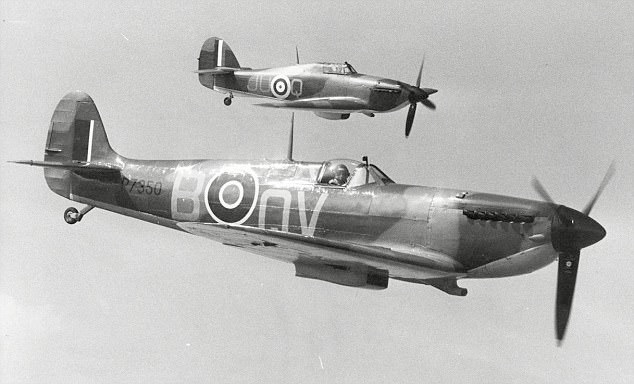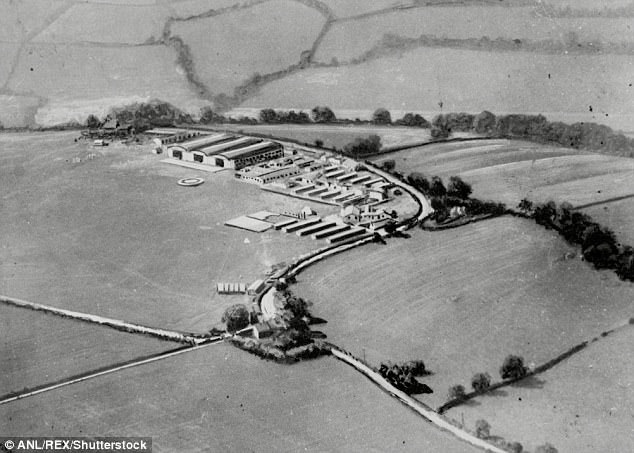The Battle of Biggin Hill: ROBERT HARDMAN reveals how the airfield that was home to our Spitfire heroes has become mired in a bitter dogfight over its fabled chapel
By Robert Hardman for the Daily Mail
PUBLISHED: 00:26, 15 September 2017
Salisbury Cathedral or York Minster it is not. Built from modern red-brick at a time of genuine austerity, it is an unobtrusive, unremarkable structure. From a certain angle, it might be a school or council hall — until you see the two monuments either side of the entrance. One is a Spitfire, the other a Hurricane.
Another clue is a stained-glass window in the form of an RAF roundel, illuminated from behind so it shines all night to the outside world like a neon light. It is a memorial erected by the Aircrew Association in honour of all Allied airmen who gave their lives for this country.
Once inside, the sense of history is overpowering. This place of worship may be a new boy compared with some grand medieval basilica, but it has just the same aura, the same sense of the sacrosanct.
St George’s Royal Air Force Chapel of Remembrance at Biggin Hill is a powerfully atmospheric reminder of that pivotal moment in history when this nation’s entire existence was in the balance. And if anywhere could claim to be the epicentre of the Battle of Britain in 1940, then it was this bombed and battered airfield on London’s Kentish fringe.

<img id="i-aa540520c50af89f" src="http://i.dailymail.co.uk/i/pix/2017/09/15/00/4449761400000578-4886046-image-m-89_1505430265211.jpg" height="416" width="634" alt="The proposed Biggin Hill museum: What has dismayed so many people is the design of the new museum - which some have likened to an ¿eyesore¿ or a public lavatory - and the fact that half the existing chapel building will be incorporated into it and, in future, only be accessible on payment of a £7.50 entry fee" class="blkBorder img-share"/>
The proposed Biggin Hill museum: What has dismayed so many people is the design of the new museum - which some have likened to an ‘eyesore’ or a public lavatory - and the fact that half the existing chapel building will be incorporated into it and, in future, only be accessible on payment of a £7.50 entry fee
Today, though, as we mark Battle of Britain Day, the chapel will be closed. It will reopen briefly on Sunday morning for the annual Battle of Britain service and then shut down again for just over a year. When it reopens, it will be as part of a new council-run museum with a shop and cafe attached.
Yet the plans for the new-look complex have so upset some locals and veterans that more than 15,000 of them have signed a petition urging a rethink. Today, a delegation will mark Battle of Britain Day by coming to Westminster to present it to Ministers.
As one of the campaigners, retired surgeon Rita Radford puts it: ‘We have spent years trying to get a museum — but not this one.’
This is certainly an unusual row. But then this is a very unusual place. We would understandably expect a passionate public outcry if officialdom were about to demolish or turn its back on an important memorial to such a revered band of national heroes.
In this case, however, neither money nor neglect is the issue. Thanks to the Treasury’s Libor fund (the pot of penalty fines paid by errant banks) and the National Lottery, this site is about to have £5 million lavished on it.

<img id="i-72cfdc954632c89a" src="http://i.dailymail.co.uk/i/pix/2017/09/15/00/4449760F00000578-4886046-Of_all_the_RAF_fighter_bases_defending_the_capital_this_one_endu-a-94_1505430754759.jpg" height="490" width="634" alt="Of all the RAF fighter bases defending the capital, this one endured more enemy attacks than any. Yet it never ceased operations, even when bombed several times in a single a day. (Above, a Spitfire in flight)" class="blkBorder img-share"/>
Of all the RAF fighter bases defending the capital, this one endured more enemy attacks than any. Yet it never ceased operations, even when bombed several times in a single a day. (Above, a Spitfire in flight)
96 year old flies a spitfire 72 years after he last flew a plane
What has dismayed so many people is the design of the new museum — which some have likened to an ‘eyesore’ or a public lavatory — and the fact that half the existing chapel building will be incorporated into it and, in future, only be accessible on payment of a £7.50 entry fee.
Furthermore, at least one veteran has pointed out that he was rather hoping to have his funeral there and cannot be entirely sure that he will outlive the building works. So many have now chosen to have their ashes buried in the garden of remembrance that it is nearly full.
Those behind the council-backed museum trust, on the other hand, flatly reject the complaints and point out that the chapel will be preserved for future generations.
So I have come for a final look before the site is sealed off until the end of 2018. Though the RAF has long since left Biggin Hill, this remains a fully functioning airfield, much of it devoted to private jets and commercial aviation.
The chapel sits in a corner near some dreary looking old RAF workshops. Stepping through the doors, though, I can’t help thinking of Doctor Who. This place is like the Tardis — ordinary on the outside but vast and enthralling within.
Even the floor on which I am standing has a story to tell. It is made entirely from old wooden aircraft propellers.
The whole place is packed with medals, plaques and tokens of gratitude from all over the world — a memorial in blue Delft tiles ‘in grateful remembrance of generous hospitality bestowed on the Netherlands’; a lectern carved in the shape of an eagle and presented by the Belgian Air Force; a collection plate of rock-hard stenka wood from South Africa; an altar frontal embroidered with the flags of all who served here, from Kiwis to Norwegians.
The communion silver was donated by American well-wishers in memory of 133 Eagle Squadron, a band of gallant U.S. pilots who volunteered for the RAF long before America had entered the war. The inscription on the chalice says it all: ‘To those who came with us and now remain for ever.’
Every stained glass window has its own story. There is one for every squadron based here during the war. Look closely at the window honouring Fighter Command and you will notice a perfectly preserved mosquito inside the glass.

<img id="i-fbef016b6daf0b4a" src="http://i.dailymail.co.uk/i/pix/2017/09/15/00/000174DC00000C1D-4886046-image-m-93_1505430441800.jpg" height="384" width="634" alt="Biggin Hill¿s reputation for dogged heroism continued all through the war. In 1943, it became the first RAF base to shoot down 1,000 enemy aircraft. (Above, a Spitfire and Hawker Hurricane flying side by side at Biggin Hill Air Fair)" class="blkBorder img-share"/>
Biggin Hill’s reputation for dogged heroism continued all through the war. In 1943, it became the first RAF base to shoot down 1,000 enemy aircraft. (Above, a Spitfire and Hawker Hurricane flying side by side at Biggin Hill Air Fair)
This was no unfortunate mistake on the production line. Rather, the glazier had flown Mosquito fighter-bombers himself during the war and wanted to include his own little tribute.
Overlooking the altar and the names of the 454 Biggin Hill aircrew who never returned is the window featuring the station badge of Biggin Hill itself — a chain and the motto ‘The Strongest Link’.
Of all the RAF fighter bases defending the capital, this one endured more enemy attacks than any. Yet it never ceased operations, even when bombed several times in a single a day. There are stained glass windows honouring the rescue services, the parachute packers, the ground crews — all of whom took a terrible pounding. This was home to heroes and heroines alike.
The radar window features three identical decorations — the Military Medal awarded to three members of the Women’s Auxiliary Air Force (WAAF) stationed here. One of them, Sergeant Joan Mortimer, manned the switchboard in the armoury all through an air raid, while sitting next to a pile of high explosives.
Before the ‘all clear’, she ran outside with an armful of flags to mark all the unexploded bombs, even as some of them were going off. She received her MM from the King.
Biggin Hill’s reputation for dogged heroism continued all through the war. In 1943, it became the first RAF base to shoot down 1,000 enemy aircraft. All the pilots were given a special ‘1,000-kill’ dinner in Park Lane and a night on the tiles. The cab drivers of London refused to accept any payment for the 12-mile ride back home to Biggin Hill.

<img id="i-a91021dea47d6141" src="http://i.dailymail.co.uk/i/pix/2017/09/15/00/444979F300000578-4886046-image-m-103_1505431027821.jpg" height="453" width="634" alt="No one had a greater admiration for Biggin Hill than Winston Churchill himself. He would often stop off here unannounced when travelling to and from his home in Chartwell, Kent, just to thank the pilots and ground crew. (Pictured above, the aerodrome in 1922)" class="blkBorder img-share"/>
No one had a greater admiration for Biggin Hill than Winston Churchill himself. He would often stop off here unannounced when travelling to and from his home in Chartwell, Kent, just to thank the pilots and ground crew. (Pictured above, the aerodrome in 1922)
By way of thanks, 50 cabbies were later invited to dinner in the mess and a tradition was established.
For the rest of the war, all Biggin Hill pilots could have a free cab ride back to base at any time, a solemn pledge marked with the presentation of a commemorative steering wheel.
It is now housed in a display case in the St George’s Room at the back of the chapel — just one of so many delightful exhibits in this noble miscellany of valour.
No one had a greater admiration for Biggin Hill than Winston Churchill himself. He would often stop off here unannounced when travelling to and from his home in Chartwell, Kent, just to thank the pilots and ground crew.
After that 1,000th ‘kill’ in 1943, it was decided that the airfield needed a memorial-cum-chapel and three pre-fabricated huts were joined together for the purpose.
The crews erected a board featuring the name of every man killed. As the list grew longer, so did the accumulation of souvenirs and mementos. But one night, in 1946, it caught fire. It was Churchill himself who led the campaign to rebuild it.
‘My personal association with Biggin Hill during the Battle of Britain lives in my mind,’ he said at the time.
‘As a nation we have short memories and it is well that memorials such as this should bring to our remembrance the cost of victory in the days when one of our fighter pilots had to be worth ten. They died without seeing the reward of their efforts; we live to hold their reward inviolate and unfading.’
Little wonder that when the Ministry of Defence decided, in 2014, that it could no longer afford the chapel’s £50,000-a-year running costs, veterans were appalled. A local campaign was already under way to raise funds for a proper museum alongside the chapel. Planning permission had been granted. But now the priority was to preserve the chapel.
Faced with public outrage, the Government pledged to keep it open and George Osborne produced £1 million from his Libor fund for the purpose. A further tranche of Libor money and a Lottery grant would follow.
But by now, with the finance assured, the council had taken command of the whole scheme and did not want a separate visitor centre alongside the chapel. Rather, the chapel would be absorbed into a single-storey museum and it would all be run by a single charitable trust.
And herein lies the problem. The protesters — some are locals, some veterans — argue that the new scheme is both underwhelming and unsightly.
‘If the council were proposing a good plan, I’d be right behind it. But their museum looks wrong. It is much smaller than the one we were proposing, it will cost twice as much and it cannot even accommodate an aircraft,’ says Gordon Wright, a local publisher who was chairman of the original scheme and supports the ‘Protect Biggin Hill RAF Chapel’ petition. A spokesman for the council-backed trust rejects the ‘misleading assertions’ in the petition.
He goes on: ‘The new museum will honour the bravery of all those in the air and on the ground’ in a ‘landmark scheme which frames the historic Chapel with a new museum; enhancing and protecting the memorial Chapel and garden within, to work as a dignified and harmonious whole’.
Though the rear half of the chapel building and its contents will become part of the ticketed museum, the chapel proper will still be free-of-charge — and its opening hours will be longer than in the past.
This toxic row is a rather sad twist to what should be a happy new chapter for an astonishing and vital building. Fortunately, some things are not changing. Messrs Spitfire and Hurricane, still guarding the entrance, are not budging.